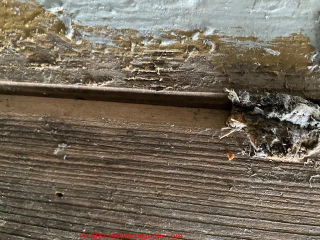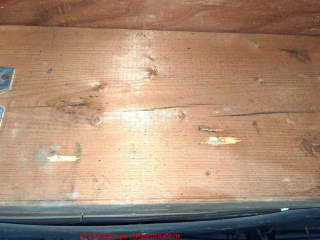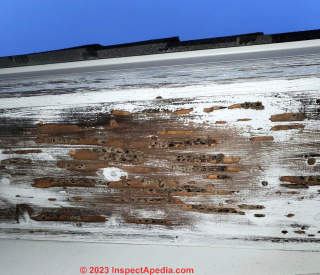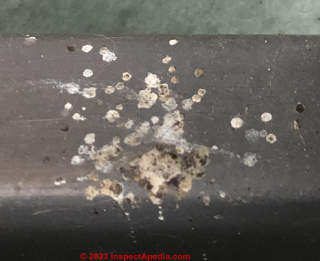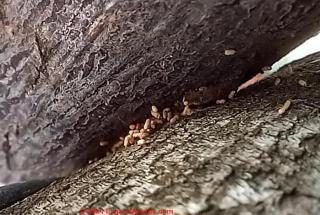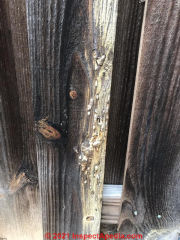 Cosmetic vs. Structural Insect Damage
Cosmetic vs. Structural Insect Damage
Harmless insect activity
- POST a QUESTION or COMMENT about how to recognize insect damage that is harmless and cosmetic instead of structural
With just a little help from experienced building inspectors or pest control operators given on this page we can often recognize signs of insects at a building that are not a worry, and don't need chemical or other treatment.
Here we describe and illustrate common indicators of insect activity at buildings that are generally producing harmless damage rather than damage to the structure. Those might be eggs, egg cases, the insects themselves, or their nests.
We include reader questions and photos and expert answers to give examples of both insect activity that is definitely harmless or only cosmetic as well as some examples of more-serious insect activity that need further attention.
InspectAPedia tolerates no conflicts of interest. We have no relationship with advertisers, products, or services discussed at this website.
- Daniel Friedman, Publisher/Editor/Author - See WHO ARE WE?
Harmless Insect Activity vs More Serious Insect Attack
Many insects found on and around buildings are harmless or produce cosmetic damage rather than damage to the structure. We start with a very common one, bagworms.
The following reader Q&A along with photos describe various signs of insect activity at buildings and help us distinguish between harmless and harmful insect activity.
Bagworms, Insect Egg Cases Don't Cause Building Damage
Encasements of bagworm moths - Psyche caste
Based in Lincoln, MA outside of Boston, we live in a 1969 designed/built cedar sided house.In removing the original 1969 AC unit which was butted up against the exterior siding, the removal exposed a small rectangular section of original unfinished cedar that has never been finished or stained.
Wood damage was seen a short while after removing the AC but was thought to be mice damage from mice exiting the house above an entry point we screened and foamed up. However - I just noticed small bundles of thread-like material - wood? - hanging off other areas of the house.
[Click to enlarge any image]
These are few in number, widely spaced, never in any pattern or density - each seems to be a 'one-off'.
They also appear on different exposures of the house - N and E and on a separate detached garage structure- also w/ cedar vertical siding.
There is no evidence of sawdust or piles of shavings beneath any hole, no lateral damage evident and although we do have woodpeckers in the woods around us, we have not had or seen them attacking the house.
I have not found any similar images on-line so am stumped.
Any insight or suggestions as to the cause - and treatment - and who I might contact for help in the area would be appreciated. Many thanks - Michael - On 2021-01-05

Above & below: unidentified gray fibrous insect or plant material found on the exterior of buildings.
I found these things (photos above and below) all over the outside of my home and am doing some research and getting help from local pest people to identify them.
How do I evaluate insect damage to a building - is it structural or only harmless and cosmetic? - On 2021-03-13 @Michael
Reply by (mod) - insect larvae or plant seeds adhered to building exterior? Encasements of bagworm moths - Psyche caste
I'll bet a 6-pack of Castle Danger beer that if you take a couple of those plant-fibre like structures to your local county farm and home center or environmental center they can identify that item.
When I first saw these I was not sure if they were insect or plant material.
We learned they were bagworm moth eggs encased in other plant material. I think that the bagwormns particularly like short plant materials like cedar or pine needles of just the diameter and length shown in this enlargement of a Psyche caste egg case that I pulled off of a wood sided building in New York.We've found these small woody constructions on the outside of building walls at many field inspections - identified as bagworm eggs encased in what look like individual cedar twig "leaves" or other plant material.
A number of readers have asked about these harmless egg structures. They can be removed by mechanical scrubbing, scraping, cleaning. Bagworms don't harm building structures.
These "insects" (really their eggs) do no more than cosmetic damage to wood or other exterior surfaces.
Your photos will be helpful to other readers.
Follow-up by Michael
Long delay on responding back but after putting the question out on the town list serv - several people chimed in - confirming that as you say, these funny things attached at one end and hanging down on my walls are the encasements of bagworm moths - Psyche caste.
The larvae make cocoons out of collected debris - twigs, plants, rubbish spun with silk - hence the twig or stick-like appearance.
They embed themselves only so far as the exterior stain on the cedar siding w/ no burrowing beyond the stain - although it may be my pulling the cocoon off pulls a spot of stain away however they adhere to the surface.
The initial confusion was that at passing glance they look like wood being burrowed from within.
Reply by (mod) - bagworm moth identification key
Michael
The illustration shows some examples of some of the larval cases of this genera, (Davis 1964)
@Michael, Thank you; these bagworm moth casing photos will be helpful to other readers, as these insects are ubiquitous, particularly where evergreens are nearby.
Some useful bagworm moth research:
- Kaufmann, Tohko. "Observations on the biology and behavior of the evergreen bagworm moth, Thyridopteryx ephemeraeformis (Lepidoptera: Psychidae)." Annals of the Entomological Society of America 61, no. 1 (1968): 38-44.
- Davis, Donald Ray, Diomedes A. Quintero, Roberto AT Cambra, and Annette Aiello. "Biology of a new Panamanian bagworm moth (Lepidoptera: Psychidae) with predatory larvae, and eggs individually wrapped in setal cases." Annals of the Entomological Society of America 101, no. 4 (2008): 689-702.
- Davis, Donald R. "BAGWORM MOTHS OF THE WESTERN HEMISPHERE (LEPIDOPTERA: PSYCHIDAE)." [PDF] Smithsonian Institution, Bulletin of the United States National Museum, Washington, D.C. (1964). Retrieved 2021/02/13 original source: https://repository.si.edu/bitstream/handle/10088/10074/1/USNMB_2441964_unit.pdf
Introduction excerpt:
This study is a preliminary revision of the tineoid family Psychidae of North and South America (including the West Indies). A treat- ment of such scope has been attempted only once (Gaede, 1936), anditwasatbestaverysuperficialstudy.
Other publishedaccounts consist mostly of original descriptions, taxonomic notes, and works treating restricted areas.
As a result, the interpretations of previous authors have been erroneous in several instances; furthermore, a comprehensive key for the genera and species has never been attempted; thus, reliable identification of many of these insects has been virtually impossible.
The purpose of the present study is to re-evaluate the decisions of earlier workers; to complete and, where necessary, to correct their conclusions; and to investigate and utilize several taxonomic criteria in order to facilitate identification and a more comprehensive under- standing of the insects presently included in this family.
The members of the family Psychidae present nmiierous problems that have greatly hindered a satisfactory treatment of the group. No single factor is unique for the family, and the close interrelation of many factors make their solution no easy task.
The frequency with which many of these problems are met in the Psychidae demon- strates why this family has been considered one of the most perplexing groups, taxonomically, to be fomid in the Lepidoptera.
Investigate These Other Signs of Insect Activity
Identify small holes on joists & beams: insect activity?
I have been noticing odd holes in the truces of my home in northern NY but I am having trouble identifying the insect because I haven't seen anything crawling around. - On 2022-10-13 by Igor
Reply by InspectApedia-911 (mod)
@Igor,
In your photo I can see some normal drying splits or checking cracks in what looks like a floor joist.
I also see some extremely small black flecks, but I can't make out what they are.
And finally I think I see a cobweb with an ant trapped in it.
Take a closer look. If that ant is the insect that you are seeing, or if you are seeing sawdust or frass appearing under or on or near the wood framing, you may have a carpenter ant infestation.
Is it Rot or Insect Damage?
I have this rot in the sophets of my home, how can I tell what caused this and should I be worried about the structure of my home. - On 2021-12-15 by Austin
Reply by Inspectapedia Com Moderator - soffit damage can be due to leaks and inadequate ventilation but this looks like insect activity
@Austin,
First let's notice that there are horizontal holes along the wood grain of this fascia board on your home's soffit. While rot may be present too, these are insect damage holes.There appears to be some sawdust-like material in some of those "gouges" along the wood grain. I can't see enough detail in your photo to know if this is carpenter ant frass (soft, all wood) or remains of termite activity (a mixture of mud and wood) but you may be able to determine that by a closer look and a bit of probing.
This damage is enough that you should get an inspection from a licensed pest control operator (PCO) to determine if the insects are active and need treatment.
Separately we need to assess the extent of damage to the structure. If it's only in the soffit fascia board I'd simply replace it. If rafter tails or rafter bodies are damaged, more repair may be needed.
Separtely, you want to inspect your roof for leaks especially at the eaves, and it's evident that you have no roof ventilation installed.
So it's also worth inspecting in your attic for signs of leaks into the attic and for the extent of moisture and mold that might be in that area.
Bird or Spider Droppings vs Holes in Wood
Hi. Got a bad problem at my house. We had been figuring it was something in the paint maybe ftom 5 years ago but now I’ve found the same thing occurring in the eucalyptus wood glider on our screened porch.
These minuscule holes with a minuscule white drip beneath them are in the millions all over our cedar shakes house and now in a totally different wood on the glider. Terminix treats for wolf spiders and they can’t figure it out. - On 2021-03-28 by Claudia
On 2021-03-29 by danjoefriedman (mod)
@Claudia, I don't have a size scale in your photo so I can't be sure but It looks to me like spider poop and very small insect holes that could be characteristic of old powder post beetles damage.
But I don't normally find powder post beetles invading building exterior siding or trim; more-likely those insects bore into sills and main beams or occasionally floor joists.
Compare what you're seeing
with POWDER POST BEETLES
and inspect further in your basement or crawl space to see if there are any signs of insect activity there.
Mud or Concrete on Wood Framing Isn't Insect Activity
We live in Southeastern Wisconsin - Does anyone know what might be causing this damage to the rafter in my basement? - On 2021-03-08
by Patty

Reply by (mod) - mud and mold on interior wood structure: previous exposure to weather?
@Patty, I see what looks like mud, thick on the sides of joists and on subflooring, with some straight edges marked in the mudas if the material was left outdoors and exposed to weather.
On the edge of some of the blocking I see what could also be a bit of fungal growth - fine black growth patterns on the edges of the doubled blocking and joists.
Sometimes we see similar material on wood framing that was used first in a concrete form, then re-used in construction. But the presence of muddy brown material on both the sides of blocking and the edges of joists and on the surface of plywood all look like mud. Yet I don't see water or flooding marks on the materials.
Is it Sap or Insect Damage
What caused this? - On 2020-02-17 by Steve
Reply by (mod) - insect damaged siding or fencing? Sap?
Steve
That's certainly interesting.
It looks like old insect damage; I can't say if the white material is sap or insect frass. The pattern and location is not characteristic of termites, but it'd be useful to poke at or pick out a bit of the white material to examine its consistency.
What I want to know is if the material is comprised of
- sawdust
- sap
- larvae
- old paint
- something else
it would also help to know
- country and city location
- type of wood (species)
- how long that wood (fencing) has been in place
- whether the wood was salvaged from some prior use
...
Reader Comments, Questions & Answers About The Article Above
Below you will find questions and answers previously posted on this page at its page bottom reader comment box.
Reader Q&A - also see RECOMMENDED ARTICLES & FAQs
On 2023-11-25 by Amanda - little white things on my trees and tomato plants
I don't know if you can maybe help me with this. I found small little white things on the frame of my tomato plant and it was also on some leaves.
Im not sure if its termites (because there was a cluster of these on the one side of the wood frame) or if its worm eggs, or what type of insects.
I had to cut half of my tomato leaves that got infected with this coz the leaves started to look sickly and dying.
On 2023-11-25 by InspectApedia Publisher
@Amanda,
Those look like larvae emerging from a nest between two logs. Too blurry to identify the species with confidence. But possibly a type of insect-scale such as Cottony Camilla scale or Cape Myrtle bark scale. They don't look fuzzy enough to be mealy bugs or wooly aphids.
Bottom line probably a type of grub or larvae.
They are not termites. You wouldn't see termites out on open surfaces like that.
...
Continue reading at CARPENTER ANTS or select a topic from the closely-related articles below, or see the complete ARTICLE INDEX.
Or see INSECT INFESTATION / DAMAGE - questions & replies posted originally on this page.
Or see these
Recommended Articles
- INSECT INFESTATION / DAMAGE - home
- BEDBUG PESTS
- CARPENTER ANTS
- CARPENTER BEES
- FLIES, MOSQUITOES REMOVE or REPEL
- HONEY BEES in BUILDING WALLS
- INSECT DAMAGE PREVENTION
- INSECT DAMAGE - WOOD REPAIR STEPS
- INSECTS & FOAM INSULATION
- MERULIPORIA FUNGUS DAMAGE
- MOLD: A COMPLETE GUIDE TO MOLD
- MOTHS, MOTHBALL ODORS
- PESTICIDE EXPOSURE HAZARDS
- POWDER POST BEETLES
- TERMITE INSPECTION & DAMAGE ASSESSMENT
Suggested citation for this web page
INSECT DAMAGE - HARMLESS at InspectApedia.com - online encyclopedia of building & environmental inspection, testing, diagnosis, repair, & problem prevention advice.
Or see this
INDEX to RELATED ARTICLES: ARTICLE INDEX to INSECT DAMAGE
Or use the SEARCH BOX found below to Ask a Question or Search InspectApedia
Ask a Question or Search InspectApedia
Try the search box just below, or if you prefer, post a question or comment in the Comments box below and we will respond promptly.
Search the InspectApedia website
Note: appearance of your Comment below may be delayed: if your comment contains an image, photograph, web link, or text that looks to the software as if it might be a web link, your posting will appear after it has been approved by a moderator. Apologies for the delay.
Only one image can be added per comment but you can post as many comments, and therefore images, as you like.
You will not receive a notification when a response to your question has been posted.
Please bookmark this page to make it easy for you to check back for our response.
IF above you see "Comment Form is loading comments..." then COMMENT BOX - countable.ca / bawkbox.com IS NOT WORKING.
In any case you are welcome to send an email directly to us at InspectApedia.com at editor@inspectApedia.com
We'll reply to you directly. Please help us help you by noting, in your email, the URL of the InspectApedia page where you wanted to comment.
Citations & References
In addition to any citations in the article above, a full list is available on request.
- Steve Bliss's Building Advisor at buildingadvisor.com helps homeowners & contractors plan & complete successful building & remodeling projects: buying land, site work, building design, cost estimating, materials & components, & project management through complete construction. Email: info@buildingadvisor.com
Steven Bliss served as editorial director and co-publisher of The Journal of Light Construction for 16 years and previously as building technology editor for Progressive Builder and Solar Age magazines.
He worked in the building trades as a carpenter and design/build contractor for more than ten years and holds a masters degree from the Harvard Graduate School of Education. Excerpts from his recent book, Best Practices Guide to Residential Construction, Wiley (November 18, 2005) ISBN-10: 0471648361, ISBN-13: 978-0471648369, appear throughout this website, with permission and courtesy of Wiley & Sons. Best Practices Guide is available from the publisher, J. Wiley & Sons, and also at Amazon.com - [3] Jeffrey Hahn, Colleen Cannon, and Mark Ascerno, "Carpenter Ants", University of Minnesota Extension, retrieved 9/19/2012, original source: http://www.extension.umn.edu/distribution/housingandclothing/dk1015.html, copy on file as [Carpenter_Ants_UMinn.pdf]
- [4] Paul Probett, Clinton Craig, Blake Probett, "An Introduction to Micro-Drilling Technology for N. Z. Structural Timber Assessment", Incodo Ltd, 4/511 Cameron Rd, Tauranga NZ, article adapted by InspectAPedia with permission, August 2012. Contact the authors by Email: Paul Probett, mail2us@incodo.co.nz , Tel: 027 28 000 36 (Mobile) Website: https://www.incodo.co.nz/ [Copy of this article on file as Microdrilling_Assessment_Incodo.pdf]
Quoting from the Incodo website the company describes its services:
- Incodo Forensic Building Pathology:
The Forensic Building Pathology division provides evidence in report form to government agencies, consultancy firms, lawyers and others, when truly independent analysis based on comprehensive testing is required. Incodo arguably has the largest, most up-to-date and comprehensive range of building investigation equipment available and has developed unique methodologies particularly in the field of non-destructive testing for leaking structures. - Incodo In situ Timber Assessment:
The in-situ Timber Assessment division provides a service whereby technicians use state-of-the-art timber resistance drill technology to profile variations in timber density associated with timber decay.
The work is done on site and the results are instant.
This technology is objective and evidential in nature and provides assessment as to whether wood is significantly decayed, suspect or suitable for retention. The technology has particular application in locating and assessing hidden decay.
- Incodo Forensic Building Pathology:
- [5] Thomas Tannert, Andreas Muller, Mareike Vogel, "Applications and limitations of NDT: a timber bridge case study", NDTCE’09, Non-Destructive Testing in Civil Engineering
Nantes, France, June 30th – July 3rd, 2009, web search 8/3/2012, original source: http://www.ndt.net/article/ndtce2009/papers/144.pdf [copy on file as Tannert_Timber_Test_144.pdf]
Abstract
The applications and limitations of different non-destructive and semi-destructive techniques to evaluate the structural integrity of timber members in a pedestrian bridge are presented as a case study.
Sophisticated assessment tools are required to detect hidden damages in timber structures: for example stress-wave techniques are used to evaluate the modulus of elasticity of bending members and resistance to drilling is used to gain knowledge of areas of changed density due to insect or moisture induced damages.
Reliably relating the gathered data to the structural integrity of the structure is a complex issue.
Bending members and connection details of a decommissioned timber bridge were evaluated using non destructive assessment tools. Eventually these parts were tested destructively to assess their remaining modulus of elasticity and load bearing capacity.
The need for improvements in the current practice is highlighted by comparing the results from the non-destructive, semidestructive and destructive tests. - [6] David Grudzinski, Advantage Home Inspections, ASHI cert # 249089, HUD cert# H-145, is a professional home inspector who contributes on various topics including structural matters. Mr. Grudzinski, Cranston RI serving both Rhode Island and Eastern Connecticut can be reached at 401-935-6547 fax- 401-490-0607 or by email to Davidgrudzinski@aol.com. Mr. Grudzinski is a regular contributor to InspectAPedia.com - see DECK FLASHING LEAKS, ROT Case Study, and BASEMENT WATER MOLD IMPACT and VERMICULITE INSULATION for examples.
- [7] Mara and Andy Gieseke, Tucson AZ, are contributors to InspectAPedia.com including photographs used at SIDING EIFS & STUCCO, CONTROL JOINT CRACKS in CONCRETE and ROT, FUNGUS, TERMITES, and are family members of website publisher Daniel Friedman.
- [8] Desert Termites, Thomas W. Fuchs, Extension Entomologist, Darrell N. Ueckert, Texas Agricultural Experiment Station, and Bastiaan M. Drees, Extension Entomologist, Texas Agricultural Extension Service, Texas A&M University System, web search 09/13/2010, original source: http://insects.tamu.edu/extension/bulletins/uc/uc-016.html
- [9] Termites - Greenhouse Gases, U.S. EPA, Environmental Protection Agency. Web search 09/11/2010, original source: http://www.epa.gov/ttn/chief/ap42/ch14/final/c14s02.pdf Quoting an interesting passage from this brief document:
Termites inhabit many different ecological regions, but they are concentrated primarily in tropical grasslands and forests. Symbiotic micro-organisms in the digestive tracts of termites (flagellate protozoa in lower termites and bacteria in higher termites) produce methane (CH4).
Estimates of the contribution to the global budget of CH4 from termites vary widely, from negligible up to 15 percent. - [10] Truly Nolen Pest Control, Tel: 866-221-4765, is a national franchise of pest control operators in the U.S. Quoting from the company's website:
Truly Nolen [has] over 80 offices located in Arizona, California, Florida, Nevada, New Mexico, Texas and Utah. The company services more than 150,000 customers and employs about 1,100 partners, with almost 50 percent service technicians. Domestic franchises are offered throughout the United States. International franchises are also established in over 30 countries. - [11] U.S. EPA. Prevention, Pesticides, and Toxic Substances. 1997. Re registration eligibility decision: Diflubenzuron. Pp. 17, 46. www.epa.gov/ pesticides.
- [12] U.S. EPA. Office of Prevention, Pesticides and Toxic Substances. 1994. Pesticide fact sheet: Hexaflumuron. Washington, D.C.
- [13] U.S. EPA. Office of Pesticide Programs. 2003.
Pesticide ecotoxicity database. Unpublished database.
U.S. EPA. Prevention, Pesticides, and Toxic Substances. 1998. Re registration eligibility decision: Hydramethylnon. Pp. 16-18, 43. www.epa.gov/pesticides. - [14] U.S. EPA. Prevention, Pesticides and Toxic Substances. Undated. New chemical New chemical fact sheet: Noviflumuron. Washington, D.C.
- [15] "Protecting Your Home from Subterranean Termite Damage", Journal of Pesticide Reform, Fall 2004, V 24 No. 3, - 6-7, Northwest Coalition for Alternatives to Pesticides/NCAP, POB 1393, Eugene OR, 97440 541-344-5044 www.pesticide.org: Web search 09/11/2010: http://www.hipspro.com/pubs/subterraneantermites.pdf
This document discusses alternatives for termite protection including reducing the attractiveness of the structure to termites (get wood away from the building, fix leaks), use of 16-grit sand (diameter 0.06 - 0.1 in) as a termite barrier 18" wide x 3" deep in crawl areas, or stainless steel mesh for the same purpose under foundations and slabs, boric acid, Diflubenzuron (insect growth regulator, risk genetic damage, EPA classed as carcinogen), Hexaflumuron (insect growth regulator, EPA didn't ID health concerns, waived some testing, partly because of anticipated very low risk of human exposure), Hydramethylnon (stomach toxicant, EPA: Carcinogen, highly toxic to fish), Noviflumuron (chemically similar to hexaflumuron), can cause anemia, EPA didn't ID other health hazards, some testing requirements waived, moderately toxic to fish). - [16] HOUSE EATING FUNGUS [Article] Meruliporia incrassata (also called "Poria" the house eating fungus) in the U.S. or Serpula lacrymans in Europe) can cause severe structural damage. Evidence of hidden "poria" may be found by expert inspection methods which include tracing sources and paths of probable Building leaks and moisture traps. Further, careful indoor particle sampling methods can often permit the presence of this mold to be identified in the laboratory.
- [17] PESTICIDES CONTAMINATE HOUSE [PDF] - news article about improperly applied pesticide chemicals and building contamination
- [18] Termite Damage Case Study#1 - exterior clues predicted insect damage; interior access was limited but certain clear clues led right to the damage as well as an attempted cover-up of termite damage below a "repaired" wooden floor. The real evidence was in the driveway. [in process]
- [19] Termite Damage Case Study#2 - very limited visual access inside a building made this inspection for structural damage tough. Outside conditions suggested a risk of water entry and insect attack. Inside the house had mysteriously sloping floors - sloping in every direction. There were few indications of ongoing building movement to explain the sloping. Perseverance led to finding severe termite damage at the building sills. [in process]
- [21] Hoadley, R. Bruce. Understanding Wood, 1980, Newton, CT: Taunton Press.
- [22] Panshin, A. J. and Carl de Zeeuw. Textbook of Wood Technology, 1980, NY: McGraw-Hill.
- [23] Story, Keith O. Approaches to Pest Management in Museums, 1985, Washington D.C.: Smithsonian Institution.
- [24] University of Wisconsin Dept. of Entymology, "Insect ID - wood attacking insects", retrieved 10/25/2012, original source http://www.entomology.wisc.edu/insectid/wood-attk.php
- In addition to citations & references found in this article, see the research citations given at the end of the related articles found at our suggested
CONTINUE READING or RECOMMENDED ARTICLES.
- Carson, Dunlop & Associates Ltd., 120 Carlton Street Suite 407, Toronto ON M5A 4K2. Tel: (416) 964-9415 1-800-268-7070 Email: info@carsondunlop.com. Alan Carson is a past president of ASHI, the American Society of Home Inspectors.
Thanks to Alan Carson and Bob Dunlop, for permission for InspectAPedia to use text excerpts from The HOME REFERENCE BOOK - the Encyclopedia of Homes and to use illustrations from The ILLUSTRATED HOME .
Carson Dunlop Associates provides extensive home inspection education and report writing material. In gratitude we provide links to tsome Carson Dunlop Associates products and services.



